FIFA World Cup
Brazil 2014
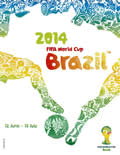 Once the true price of hosting the World Cup became clear, the initial jubilation of the Brazilian public turned sour. Official government projections in 2010 for new stadia soared from R$5.3 billion (£1.38bn) to R$8 bn (£2.08bn) by 2013 while the total cost of hosting the tournament, taking into account infrastructure costs, was R$25.8bn (£6.7bn). This compares to a total cost estimated at £2.44bn for the previous tournament in South Africa.
Once the true price of hosting the World Cup became clear, the initial jubilation of the Brazilian public turned sour. Official government projections in 2010 for new stadia soared from R$5.3 billion (£1.38bn) to R$8 bn (£2.08bn) by 2013 while the total cost of hosting the tournament, taking into account infrastructure costs, was R$25.8bn (£6.7bn). This compares to a total cost estimated at £2.44bn for the previous tournament in South Africa.
In 2013 street protests during the warm up Confederations Cup competition against the lack of government spending on social welfare and endemic corruption were met with tear gas. Further unrest was caused as the government sought to reduce security concerns by clearing the slum favellas in the vicinity of host cities. A popular slogan among protesters was "We demand FIFA standard hospitals and schools."
One thing, however, was clear. FIFA would contribute nothing towards these costs. FIFA's profits from World Cup tournaments are exempt from tax while the organisation's aggressive commercial policies (enshrined in law as a condition of hosting the competition) forbid any trading by local enterprises not on the list of official sponsors in or near World Cup venues.
FIFA amended Rule 2 Section 35 of the competition regulations to state, "Each team shall inform FIFA of two different and contrasting colours. One predominantly dark and one predominantly light for its official and reserve kit." Although this rule does not require teams to wear single colour kits, several manufacturers interpreted it in this way.
This was the first tournament in which goal-line technology was used.
Group A | Group B | Group C | Group D | Group E | Group F | Group G | Group H | Knock Out Stages
| 2010 Tournament | World Cup Index | 2018 Tournament |
Group A
 Brazil
Brazil
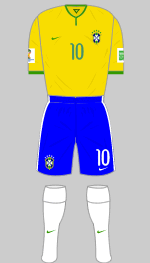
First
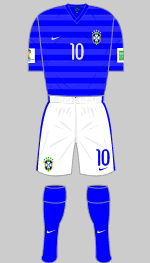
Second
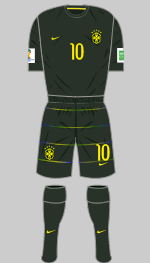
Home
Designer: Nike
Nike's design for the hosts is solidly traditional with green tape trimming the neck. As expected, there are extravagant claims for the material, which now includes micro-fine pinholes in the numbers to aid cooling and laser-cut ventilation holes on the side of the torso. Cotton is woven into the polyester to wick sweat away from the body. The small motif below the back of the neck is a canary, one of the nicknames used in Brazil for the national team.
The second kit is in the usual blue/white colours and has textured bands running across the shirt. We expect white or blue shorts will be worn with both sets as required. The third kit, which may be aimed at the replica market rather than the competition itself, is in very dark green (celebrating Brazil's lush rainforests and exciting nightlife and worn with surfer-style shorts). Whatever.
(George Pannell)
 Croatia
Croatia
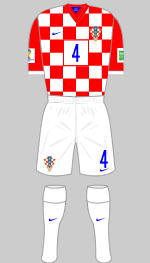
First
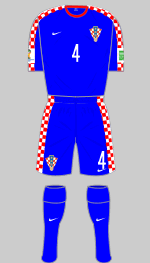
Second
Designer: Nike
Croatia will wear their usual chequered shirts as first choice and bright blue as second choice. The first choice shirt has red sleeves and a solid red panel between the shoulders and upper waist on the reverse to accommodate squad numbers and player names. The second choice is, as usual, all blue with chequered trimmings.
(Ronny Ayres)
 Mexico
Mexico
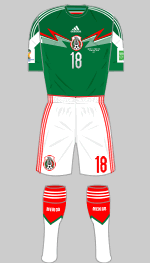
First
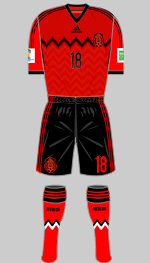
Second
Designer: Adidas
Mexico's first choice strip is in traditional colours with a striking lightning motif across the chest. The reserve kit, launched in February is in deep red and black with a different interpretation of the lightning theme.
All Adidas' World Cup shirts feature horizontal stripes across the back of the shoulders in the strip's secondary colours.
(Rich Wrigley, Manuel Garcia Romero)
 Cameroon
Cameroon
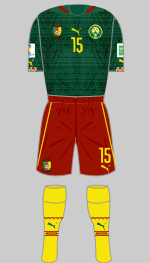
First
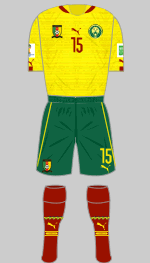
Second
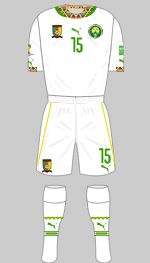
Third
Designer: Puma
Puma maintain their tradition of providing dramatic strips for African sides with locally influenced design touches. The watermark features motifs from cave paintings, a walking lion and the words "Lions Indomptables." The white kit was worn in pre-tournament matches but was not required in the finals.
(George Pannell)
Group B
 Spain
Spain
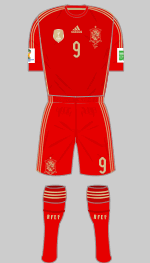
First
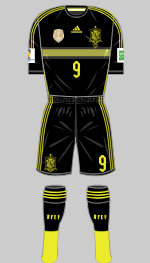
Second
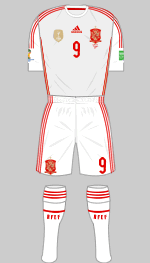
Third
Designer: Adidas
The world champions revealed their new World Cup strip in November. The detailing is in metallic gold but the most controversial feature is the substitution of red shorts for the traditional blue. The change strip is black with electric yellow and grey detailing.
FIFA instructed the Spanish Football Federation to
order a set of white strips for the opening match against the Netherlands.
(Andrew Mihaleff)
 Netherlands
Netherlands
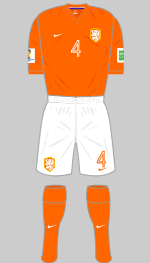
First
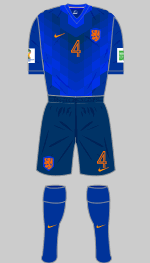
Second
Designer: Nike
To mark their 125th anniversary the KNVB have revived the old version of the traditional lion crest for their team's new strips. Orange shorts may be worn with the first choice kit. The dark blue reserve kit features a pattern of graded chevrons on the shirt.
(George Pannell)
 Chile
Chile
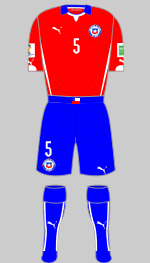
First
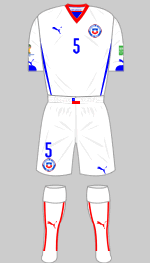
Second
Designer: Puma
Chile's strips are traditional and, in contrast to some of the designs on show in Brazil, conservative. The components are all interchangeable.
 Australia
Australia
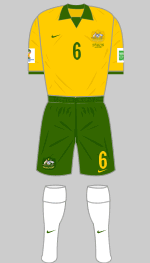
First
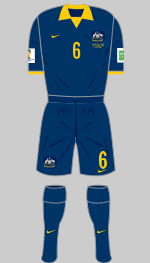
Second
Designer: Nike
The Socceroos will wear their traditional gold/green first choice with dark navy as the alternative. The first choice is based on a memorable strip from the 70s complete with flappy collar and white stockings.
(Ronny Ayres)
Group C
 Colombia
Colombia
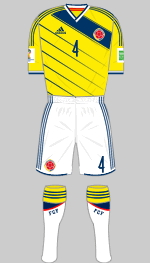
First
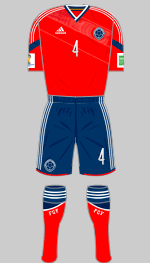
Second
Designer: Adidas
Thanks to FIFA's silly new rule, Colombia turn out in unfamiliar white shorts. The use of navy trim rather than the usual mid-blue harks back to the colours they wore when they qualified for the 1962 World Cup finals, their first appearance.
The second strip is red and navy with white trim.
 Greece
Greece
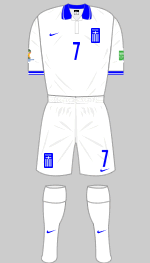
First
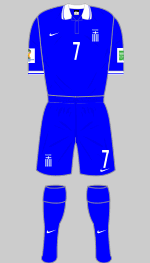
Second
Designer: Nike
Nike have supplied Greece with new strips straight out of the catalogue in the Teamwear II template. They're really not trying.
 Cote d'Ivoire
Cote d'Ivoire
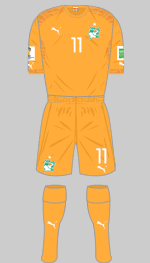
First
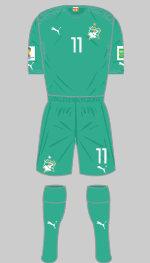
Second
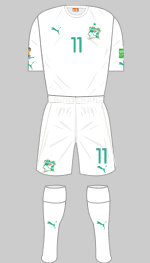
Third
Designer: Puma
Puma's signature motif for African kits takes the form of a subtle watermark at the shoulders, side and cuffs. The familiar crest (an elephant balancing a football on its trunk) is now superimposed on an outline of the country. A white third kit is available and was used in warm-up matches.
(George Pannell)
 Japan
Japan
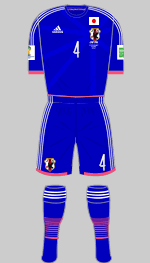
First
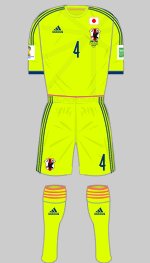
Second
Designer: Adidas
Pink trim was worn by Japan's women's team during their succesful 2012 Olympics campaign and now appears on the men's strip. A textured "rising sun" motif emanates from the crest.
The alternative is in "electricity yellow."
Group D
 Uruguay
Uruguay
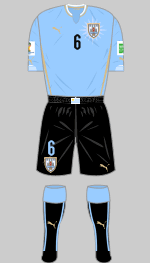
First
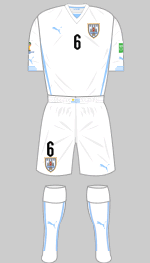
Second
Designer: Puma
Pale gold trim features on Uruguay's first choice kit while the alternative is, as usual, all white with light blue trim.
(Ronny Ayres)
 Costa Rica
Costa Rica
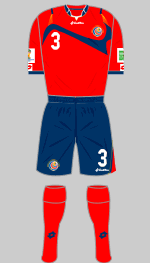
First
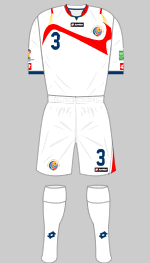
Second
Designer: Lotto
Cost Rica's new shirts are adorned with a contrasting flash across the chest.
(George Pannell)
 England
England
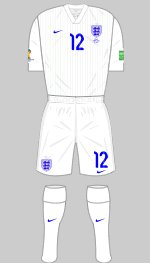
First
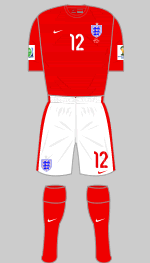
Second
Designer: Nike
Despite having introduced new kits last year after Nike took over from Umbro, the FA will launch another set for the World Cup. The first choice strip is plain white with mid blue applications and subtle pinstripes on the shirt. The single star above the crest is embroidered in silver thread. The change strip is a traditional combination of red and white, although the red is a slightly darker shade than we are used to.
(Ronny Ayres)
 Italy
Italy
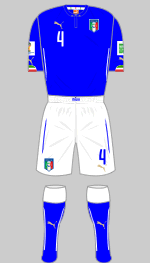
First

Second
Designer: Puma
The latest ATCV template is adopted for Italy's World Cup strip. The white second choice has trimmings in the colours of the Italian flag, which also appear on the sleeves and inside the plaquet of the first choice shirt.
(Ronny Ayres)
Group E
 Switzerland
Switzerland
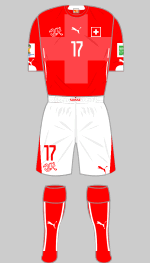
First
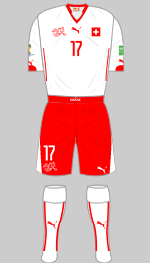
Second
Designer: Puma
There are no surprises with the Swiss first choice kit, which is simply updated from the previous Puma template.
The alternative is reversed, as usual.
 Ecuador
Ecuador
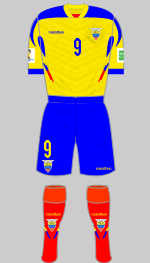
First
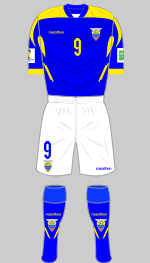
Second
Designer: Marathon
Marathon Sports, who are based in Ecuador, have supplied the national team since 1994 and their new World Cup set was launched at the end of February. The national colours are reproduced with some subtle texturing embossed into the shirt.
(Ronny Ayres)
 France
France

First
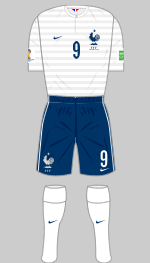
Second
Designer: Nike
Nke's latest elegant designs maintain the recent tradition of stylish strips for the French team. There is a neat, retro collar while the famous cockerel badge is now modeled on the 1958 version rather than the modernist styles of recent times. The dark blue shirt is coloured and textured to represent denim, a reference to the origin of this fabric in Nîmes (tissu de Nîmes).
The second strip is white
with navy shorts so elements will be interchangeable, which should keep FIFA's kit police happy.
(Ronny Ayres)
 Honduras
Honduras
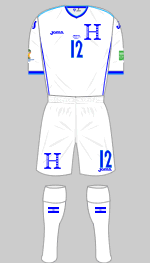
First
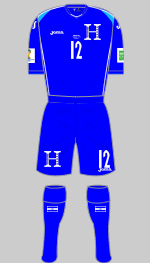
Second
Designer: Joma
Honduras' strips appear rather plain but there are some interesting features. Both outfits have turquoise details and the large "H" that always appears on their kits are embellished by the word "HONDURAS" on the right hand leg and the five stars from the national flag on the left.
(Ronny Ayres)
Group F
 Argentina
Argentina
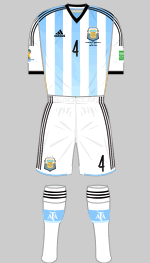
First
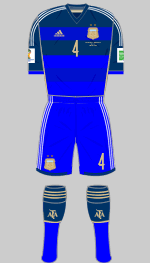
Second
Designer: Adidas
FIFA's latest injunction on strips has led Argentina to wear white shorts as first choice for the first time in their history. The result is smart but just not right: black shorts and socks are also available and we can only hope that these are used.
The stripes on the first shirt are graded to suggest a rippling flag.
(George Pannell)
 Bosnia-Hercegovina
Bosnia-Hercegovina
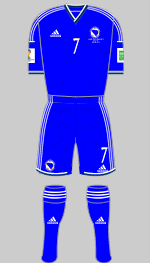
First
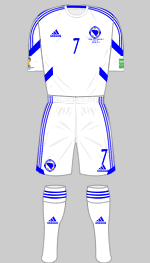
Second
Designer: Adidas
The national team has worn Legea strips recently but in March the president of the Bosnia & Hercegovina Football Federation, Elvedin Begić, announced a new deal with Adidas.
(George Pannell, Aidan Reeves)
 Iran
Iran
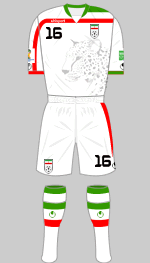
First
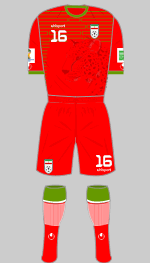
Second
Designer: Uhlsport
Iran's first choice kit is a standard Uhlsport template trimmed in the national colours. The most striking feature is the image of the endangered Asian cheetah printed into the fabric. This also appears on the all-red second kit, which has fine green lines across the top and white ones across part of the socks.
(Faramarz)
 Nigeria
Nigeria
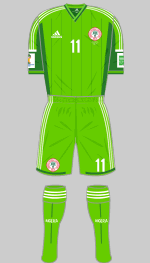
First
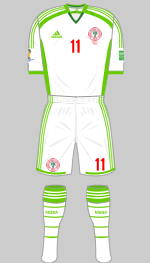
Second
Designer: Adidas
Nigeria traditionally wear all-green and for this tournament, Adidas have delivered a two tone strip with white trimmings with an all-white alternative.
(Ronny Ayres)
Group G
 Germany
Germany
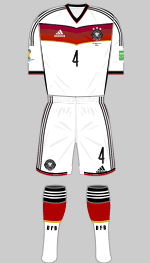
First
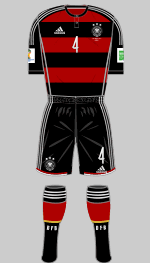
Second
Designer: Adidas
Replacing Germany's traditional black shorts is a disgraceful result of FIFA's latest petty injunction. The graded dark red chevron on the chest is edged in black and gold, maintaining the tradition of including the colours of the national flag in the shirt but this detailing is practically invisible. Altogether, this is, in HFK's view, the worst design that Adidas have produced for the DFB.
The alternative is a non-traditional combination but
the black shorts and socks are likely to be used in some games with the white shirt, creating a more familiar appearance.
(George Pannell)
 Portugal
Portugal
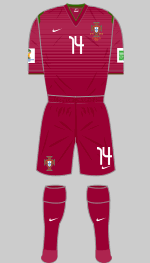
First
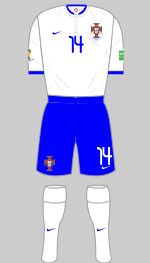
Second
Designer: Nike
Portugal are wearing an attractive shade of port red for the World Cup with graded, horizontal bands across the front of the shirt. The crest is enhanced by gold script to mark the centenary of the Portuguese Football Federation. The change strip marks a welcome return to tradition: the white/blue combination was the official change strip when Portugal made their first appearance in the World Cup finals in 1966. The detail below the rear of the collar is the cross of the Order of Christ, associated with the great Portuguese explorer, Vasco da Gama, a motif that forms part of the country's national emblem.
(Ronny Ayres, Jairo Moreno, George Pannell)
 Ghana
Ghana
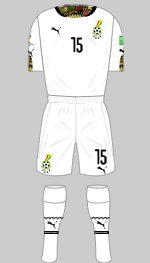
First
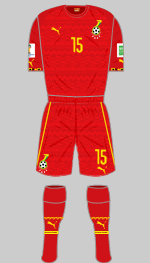
Second
Designer: Puma
The motif at the collar and on the sleeves of the white shirt is inspired by traditional kente cloth design, a colourful woven fabric typical of Ghana.
The reserve strip is in chili red with a complex pattern printed into the front of the shirt that continues on the shorts.
 United States
United States
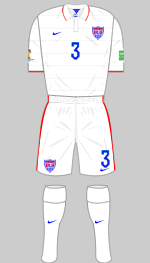
First
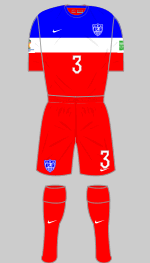
Second
Designer: Nike
The USA's strips will be worn for just one year. The second kit is in red, white and blue.
(Ronny Ayres)
Group H
 Belgium
Belgium
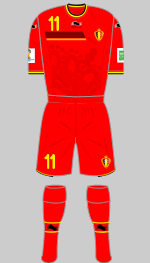
First
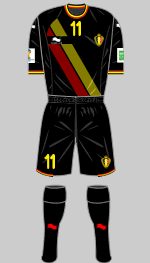
Second
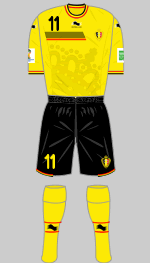
Third
Designer: Burrda
Burrda have created an outstanding set of strips for the Belgian FA in the national colours. The faded effect on the shirt trim is very original while the red and yellow shirts feature a watermark made from the crown detail of the crest.
(Sytse Korts, Andrew Skelton)
 Algeria
Algeria
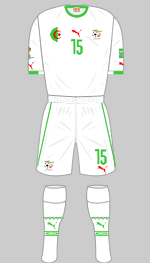
First
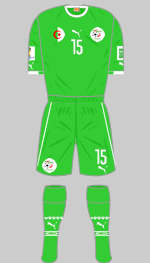
Second
Designer: Puma
Puma's latest kits for Algeria are in their usual white trimmed in light green, reversed for the change strip.
 Russia
Russia
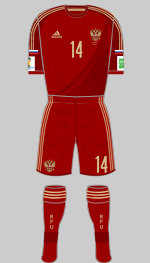
First
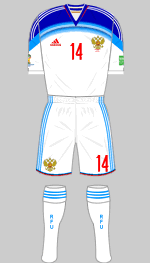
Second
Designer: Adidas
Adidas have taken inspiration from the Soviet space programme for Russia's new outfits. The imprint on the dark red first kit represents the tower above the Cosmonauts Museum in Moscow while the legend "пoеxали!" (Let's Go!), the words of Yuri Gagarin during the launch of Vostok in 1961, when he became the first human in space, is printed on the back. The white reserve strip features a graphic representing the view of the Earth's horizon as seen by Gagarin.
(George Pannell)
 Republic of Korea
Republic of Korea
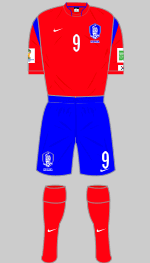
First
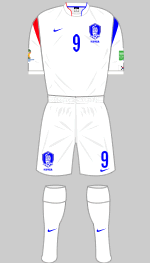
Second
Designer: Nike
Apart from the rather nice mandarin collar and the neat flashes at the shoulder, there is nothing exceptional about the Korean strips.
(Leo Howard)
 Once the true price of hosting the World Cup became clear, the initial jubilation of the Brazilian public turned sour. Official government projections in 2010 for new stadia soared from R$5.3 billion (£1.38bn) to R$8 bn (£2.08bn) by 2013 while the total cost of hosting the tournament, taking into account infrastructure costs, was R$25.8bn (£6.7bn). This compares to a total cost estimated at £2.44bn for the previous tournament in South Africa.
Once the true price of hosting the World Cup became clear, the initial jubilation of the Brazilian public turned sour. Official government projections in 2010 for new stadia soared from R$5.3 billion (£1.38bn) to R$8 bn (£2.08bn) by 2013 while the total cost of hosting the tournament, taking into account infrastructure costs, was R$25.8bn (£6.7bn). This compares to a total cost estimated at £2.44bn for the previous tournament in South Africa. Brazil
Brazil


 Croatia
Croatia

 Mexico
Mexico

 Cameroon
Cameroon


 Spain
Spain


 Netherlands
Netherlands

 Chile
Chile

 Australia
Australia

 Colombia
Colombia

 Greece
Greece

 Cote d'Ivoire
Cote d'Ivoire


 Japan
Japan

 Uruguay
Uruguay

 Costa Rica
Costa Rica

 England
England

 Italy
Italy

 Switzerland
Switzerland

 Ecuador
Ecuador

 France
France

 Honduras
Honduras

 Argentina
Argentina

 Bosnia-Hercegovina
Bosnia-Hercegovina

 Iran
Iran

 Nigeria
Nigeria

 Germany
Germany

 Portugal
Portugal

 Ghana
Ghana

 United States
United States

 Belgium
Belgium


 Algeria
Algeria

 Russia
Russia

 Republic of Korea
Republic of Korea
